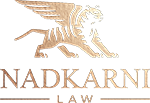Frequently asked questions
How Can Nadkarni Law Help You?
A patent is an exclusive right or monopoly granted to an inventor(s) by the government of the United States to exclude others from making, using, selling or offering for sell the invention(s) throughout the United States, or importing into the United States for the duration of the patent term.
A patent gives the Applicant/Owner, an exclusive right over an invention for a duration of the patent term. After acquiring a patent, the Applicant/Owner can make financial gains by either exploiting the invention into a commercial product or license it to others for handsome royalties or other considerations.
There are three types of patents: 1) Utility, 2) Design and 3) Plant. A utility patent protects functional (useful) aspects of an invention. A design patent protects ornamental or design features of the invention. A plant patent protects asexually reproduced plants. A utility and plant patent term lasts for 20 years from date of filing while a design patent term lasts for 14 years from date of filing.
A copyright is an exclusive protection granted to the author of an original work that is placed in a tangible medium. Copyrights include literary, dramatic,
musical, architectural, cartographic, choreographic, pantomimic,
pictorial, graphic, sculptural, and audiovisual creations.
Federal registration of an original copyrighted work allows the owner of the copyright to have a legal standing to bring a lawsuit as a Plaintiff in a court against potential infringers, and be eligible to receive damages for alleged infringement. Without a registered copyright, you cannot bring a suit in a federal court and seek damages.
Copyright can be granted on literary, dramatic, musical, artistic, and certain other intellectual works. Work(s) created after January 1, 1978, are protected for as long as the life of the author plus an additional 70 years. For anonymous, pseudonymous or a work made for hire, the copyright is protected for 95 years from the year of publication or 120 years from the year of its creation, whichever expires first.
A trademark can be a word, phrase, logo, graphic symbol or design, or a combination of words, phrases, logos, symbols, or designs that helps consumers identify the source of the goods or services and distinguish them from other competitors. Trademarks can also be used for distinctive shapes or packaging, commonly known as trade dress.
Registering a trademark makes it easier for the trademark owner to protect it against potential copiers, and puts everyone on notice that you are the exclusive owner of the trademark. Registering your trademark typically is a prerequisite for claiming damages for infringement and unfair competition in a court.
Types of marks include trademarks, service marks, collective marks and certification marks. The protection of trademark will generally last as long as the mark is used in commerce and defended against infringement.
A licensing agreement legally binds and allows two or more parties to memorialize a business relationship as it evolves over the term(s) of the agreement. It should accurately define relevant terms, length of the agreement, grant of intellectual property rights, remedies, termination rights, and ultimately prevent litigation.
Allows greater flexibility and reduces risks of over or undervalued Intellectual Property. Provides royalties or contingent payments for the Licensor, without sacrificing ownership of the Intellectual Property.
Depends on the provisions of the Licensing Agreement between the Licensor and the Licensee.
